This post contains affiliate links. We may get paid an affiliate commission if you buy something or take an action after clicking one of the links on this web page.
The tomahawk is a North American hand-axe first used by the Algonquian Indians. Originally made from stone, the introduction of metal blades came with the arrival of the Europeans to North America. The tomahawk remains one of the most versatile bladed tools in existence. Modern uses of the hawk include breaching, rescue, survival, and close-quarter combat.
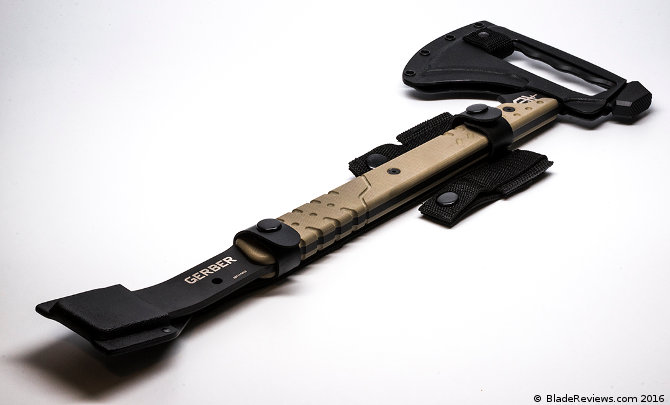
Buy the Gerber Tomahawk at BladeHQ
The tomahawk has seen a huge surge in popularity over recent years. The Gerber Downrange Tomahawk is just one example of the modernization of this classic weapon and tool.
Purpose
From the moment you lay your eyes on it, it is evident that the Gerber Downrange Tomahawk has one purpose, and one purpose only—destruction! Sure, you can take this tool camping and use it to chop fire wood and drive tent stakes, but it would be like using a tank to drive your date to the prom. This tool is made for breaching—designed to remove unwanted doors form walls and unwanted walls from doors.
General Dimensions and Blade Details
The Downrange Tomahawk (DRT) has a three-purpose axe head designed to pack the most function into this breaching tool: A beveled edge for chopping through drywall, doors, vehicle skins, rope, etc.; a hammer head for busting locks, doorknobs, hinges, and the like; and a cutaway grip for controlling the pry bar end. Measuring at 19.27 inches, the Downrange Tomahawk is one of the larger “tactical” tomahawks on the market. While this makes it a little more cumbersome to pack around, it definitely adds to its leveraging capabilities when used as a pry bar.
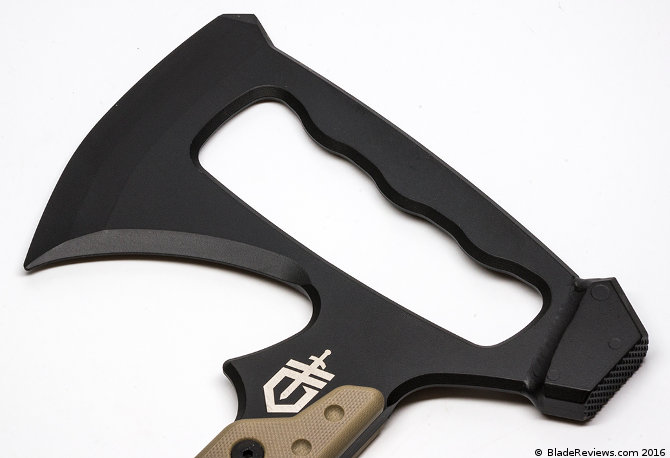
With the exception of the welded on hammer head, the DRT is made from a solid piece of 420HC steel and finished with a black Cerakote™ coating. A sweeping beard that comes to a point at the heel gives this hawk excellent hooking capabilities, which can be used for ripping out the busted shards of its target, or for hooking onto stumps and logs when climbing up difficult terrain.
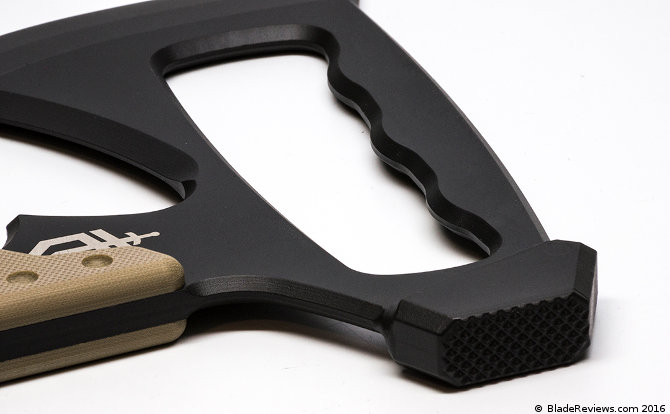
One of the major complaints that I have heard voiced by customers is the DRT’s lack of a sharpened edge. This usually comes from those who fail to understand the intent of this breaching tomahawk. A sharpened bevel is great for chopping wood and other cutting tasks; however, when it comes to breaching a door or cutting through the skin of a downed UH-60 Black Hawk helicopter, a sharpened bevel tends to over penetrate and get stuck, making the task more difficult. Gerber’s thought process then, was that their tomahawk could easily be sharpened for survival and bushcraft use, but with breaching and rescue being the primary focus of this design, a less aggressive bevel was ideal.
Handle and Ergonomics
The DRT has integrated tan G10 handle scales that contour with the jimping on the upper and lower portions of the handle. The bottom portion of the handle has jimping on both the front and back, whereas the top portion of the handle has jimping only on the front. The aggressive jimping makes for a very secure grip, especially when wearing gloves. The location of the jimping on the bottom portion of the handle is in the perfect location for gripping the tomahawk for maximum chopping leverage.
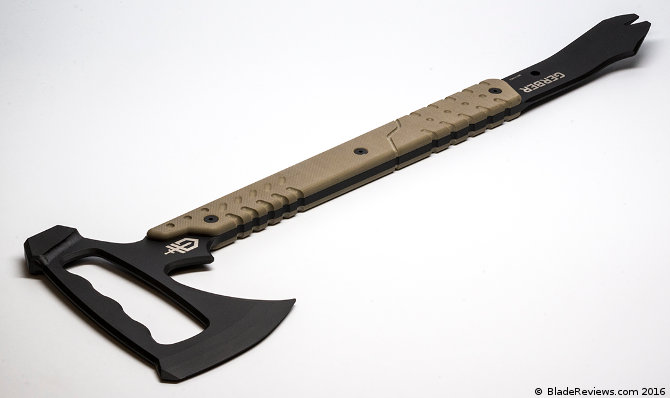
As mentioned earlier, the head doubles as a handle for the pry bar via a cutaway in the center. The addition of four finger groves creates a nice home for your hand inside the handle. There is also a small guard where the head and the handle meet. This guard protects your hand from getting smashed when you are choking up on the hawk.
Sheath
A tool like the DRT is rendered useless if it is not accessible when you need it. The best breaching tool in the world won’t open a single door if it is sitting back in vehicle you drove to the objective. The DRT is made packable through a MOLLE-compatible sheath system that incorporates a molded pry bar sleeve attached to nylon webbing. Two snapping retention bands secure the tomahawk in place. Two side-by-side MOLLE attachments at the top and a centered MOLLE attachment at the bottom of the webbing can be used to attach the DRT to a pack, standard webbing, or body armor so that the DRT goes where you go.
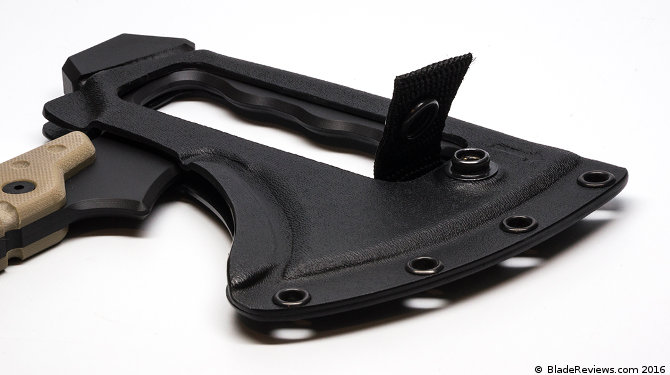
There is a separate portion of the sheath system that covers the tomahawk’s head. The head cover slides over the head and secures in place with a snapping nylon strap. This cover leaves the hammer head and the cutaway handle exposed so the pry bar and hammer can be used with the head cover in place. This reduces deployment time by eliminating the need to remove the cover unnecessarily, while acting as a safety measure to keep the edge covered during prying.
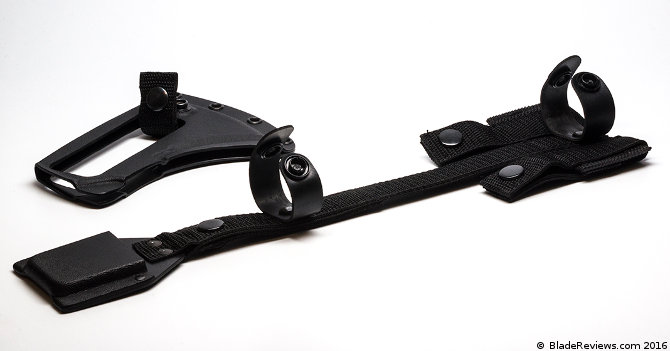
Testing
I took the DRT out to a building that was scheduled for demo and put it through the paces. Doors, drywall, and sheet metal were no match for the DRT. I was able to turn an interior door into splinters within a matter of seconds and the bevel worked like a can opener on the sheet metal. The pry bar also worked like a charm for separating doors from their frames. Using the hammer head, I was able to remove door knobs and hinges with a few whacks. Cinder block also proved to be of little consequence when it came to stopping the DRT.
Gerber Downrange Tomahawk Review – Final Thoughts
The Gerber Downrange Tomahawk is an extremely versatile breaching tool that performs as advertised. I was actually a bit surprised by its performance. I am a bit of a steel snob and 420HC is not one of my favorite steels. While 420HC is on the higher end of the 400-grade stainless steels, it is a low-grade blade steel generally speaking. I have learned, though, that I am often surprised by the performance of some of these lower grade steels when they are properly hardened. I have not tried putting an edge on the DRT, so I do not know how well this 420HC hawk will retain an edge, but as it is out of the box, it performed well.
Compared with offerings from boutique brands like Hardcore Hardware, RMJ Tactical, and Dawson knives, the DRT is priced appropriately at under $200 retail. I definitely recommend the Gerber Downrange Tomahawk for anyone looking for an effective breaching/rescue tomahawk.
- DURABLE CAMPING GEAR: Features a multi-purpose breaching tool, with axe head with beveled edge, hammer head, and integrated pry bar for ultimate control in tactical situations
- INNOVATIVE DESIGN: USA-made from 420HC steel with a corrosion-resistant Cerakote finish, ensuring this survival tool won't bend or break under pressure
- VERSATILE OUTDOOR ACCESSORY: Combines the functionality of a tactical tomahawk, hammer, and pry bar in one compact multi-tool, perfect for various tactical and survival scenarios
- COMPACT AND CONVENIENT: Includes a low-profile MOLLE-compatible sheath for easy attachment to your pack, standard webbing, or body armor, great portable tactical gear
- OUTDOOR ESSENTIALS: Ideal for hunters, soldiers, tradesmen, and outdoor enthusiasts; a crucial addition to any tactical load-out or essential survival kit equipment; Backed by the Gerber Guarantee, a limited lifetime warranty
I recommend purchasing the Gerber Downrange Tomahawk at Amazon or BladeHQ.
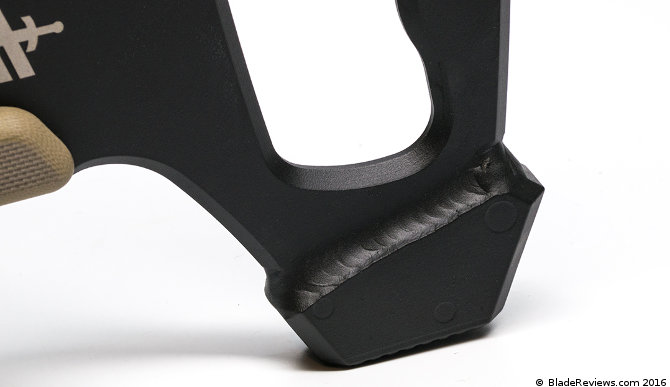

I just think this hawk is one of the coolest looking things in years. I find lower grade stainless steels are pretty favorable on larger, harder use tools like axes and big knives. Its got the ductility of the much loved carbon steels with the added bonus of rust resist. Its only when it faces abraisive materials like cardboard that it starts to become unstuck. Thanks for reviewing this tool!
Hi Pete,
I was pretty excited when Chad brought me this review. It’s definitely not something I could get away with reviewing myself (as a regular suburban guy).
I don’t have a ton of experience with stainless steel axes and big knives – most of my experience with those kinds of tools has been with high carbon steel. That said, if you can achieve the requisite level of toughness, I can definitely see the merits of stainless steel.
Best,
Dan
Great write up! I’m actually not a fan of tomahawks, but this one delivers in so many areas that others lack. I love the crowbar and G20 handle, which in my opinion gives it much more purpose that you typical tactical tomahawk that you find on the market these days. It’s useful enough to keep in your garage, although at a hefty price tag. What I’m curious about is how it holds up against dents and impacts, anyone have any feedback after some extended use?
I have used it to open walls and such in the fire department as a boss. No complaints. Looks like new.